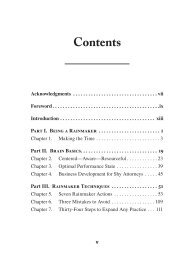(Bk Business) Carol Kinsey Goman Ph.D.-The Nonverbal Advantage_ Secrets and Science of Body Language at Work -Berrett-Koehler Publishers (2008)
Just
Just
You also want an ePaper? Increase the reach of your titles
YUMPU automatically turns print PDFs into web optimized ePapers that Google loves.
Chapter 8: <strong>The</strong> Power <strong>of</strong> Touch<br />
135<br />
TRY THIS<br />
Try increasing your communic<strong>at</strong>ion impact by<br />
adding a touch now <strong>and</strong> again—but remember to use your<br />
common sense about proper behavior in a pr<strong>of</strong>essional<br />
setting. Here are a few things to keep in mind:<br />
Look for signs <strong>of</strong> discomfort. People signal a reluctance<br />
to be touched by crossing their arms <strong>and</strong> legs, pulling<br />
back, <strong>and</strong> buttoning or holding on to their jackets.<br />
Limit the contact to the h<strong>and</strong>s, arms, shoulders, <strong>and</strong><br />
back. And be aware th<strong>at</strong> touching bare shoulders or backs—<br />
which female summer <strong>at</strong>tire may expose—can be perceived<br />
as a personal r<strong>at</strong>her than a business gesture.<br />
Make the touch light <strong>and</strong> short (only long enough to<br />
establish a positive nonverbal signal) <strong>and</strong> then step back.<br />
Who Touches Whom?<br />
Political <strong>and</strong> symbolic messages are expressed <strong>and</strong> reinforced<br />
by various forms <strong>of</strong> touch—<strong>and</strong> their avoidance. Directly<br />
touching people with special st<strong>at</strong>us is <strong>of</strong>ten <strong>of</strong>f-limits, <strong>and</strong> to<br />
breech this boundary is a sign <strong>of</strong> disrespect or defiance. <strong>The</strong>re<br />
was an outcry a few years ago when the Australian prime<br />
minister lightly touched Queen Elizabeth II on her visit to<br />
Australia. While defended as a token <strong>of</strong> hospitality, many<br />
British citizens took it as a flagrant insult to royalty.<br />
In most business environments <strong>and</strong> organiz<strong>at</strong>ions,<br />
touching is a nonverbal signal <strong>of</strong> the boss/subordin<strong>at</strong>e rel<strong>at</strong>ionship.<br />
And in most cases, it’s the boss who does the touching.<br />
It is quite common (<strong>and</strong> usually favorably accepted) for<br />
a manager to touch the shoulder, upper back, or arm <strong>of</strong> an<br />
employee while saying, “Good job!” It is far less common for<br />
the employee to act in kind.




